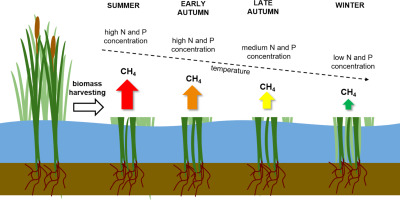当前位置:
X-MOL 学术
›
Sci. Total Environ.
›
论文详情
Our official English website, www.x-mol.net, welcomes your
feedback! (Note: you will need to create a separate account there.)
Experimental harvesting of wetland plants to evaluate trade-offs between reducing methane emissions and removing nutrients accumulated to the biomass in constructed wetlands.
Science of the Total Environment ( IF 8.2 ) Pub Date : 2020-01-27 , DOI: 10.1016/j.scitotenv.2020.136960 K Kasak 1 , A C Valach 2 , C Rey-Sanchez 2 , K Kill 3 , R Shortt 2 , J Liu 4 , I Dronova 5 , Ü Mander 3 , D Szutu 2 , J Verfaillie 2 , D D Baldocchi 2
Science of the Total Environment ( IF 8.2 ) Pub Date : 2020-01-27 , DOI: 10.1016/j.scitotenv.2020.136960 K Kasak 1 , A C Valach 2 , C Rey-Sanchez 2 , K Kill 3 , R Shortt 2 , J Liu 4 , I Dronova 5 , Ü Mander 3 , D Szutu 2 , J Verfaillie 2 , D D Baldocchi 2
Affiliation

|
Constructed wetlands built for water treatment often need biomass harvesting to remove nutrients from the system. Usually harvesting is done during the peak growing season to maximize the amount of nutrients removed from the system. This, however, can create huge methane fluxes that escape from plant tissues to the atmosphere. We used manual chambers and eddy covariance measurements to analyze the increase in methane emissions due to the harvesting of two common wetland species, Typha spp. and Schoenoplectus spp., in two climatically different constructed wetlands in Estonia and California. In addition, we determined the biomass nutrient and carbon concentrations from harvested biomass. We found that harvesting during the summer season, e.g. June and August, resulted in a significant release of methane at both sites. At the California site, baseline median methane emissions were 217.6 nmol m-2 s-1, and harvesting resulted in increases to 395.4 nmol m-2 s-1 that decreased to baseline emission within three days. Footprint modeling demonstrated that the emission increases measured by eddy covariance were dominated by contributions from the cut area to the total footprint signal. At the Estonian site, harvesting resulted in methane increases of 15.9 nmol m-2 s-1 to 110.4 nmol m-2 s-1 in August. However, in September and October the emission was significantly lower. Plant biomass analyses showed clear temporal dynamics in terms of nutrient concentration, being highest in summer and lowest in winter. Our experiments indicate that the optimal time for aboveground biomass harvesting is at the end of the growing season before nutrient translocation to belowground plant structures begins coinciding with lowest methane emissions. Therefore, strategic planning of the harvest timing may help reduce greenhouse gas emissions from managed wetlands and thus improve their multi-faceted ecological benefit.
中文翻译:

对湿地植物进行实验性收获,以评估减少甲烷排放量和去除人工湿地中积累到生物质中的养分之间的权衡。
为水处理而建造的人工湿地通常需要收获生物质才能从系统中去除养分。通常在高峰生长季节进行收获,以最大程度地从系统中去除养分。但是,这会产生大量的甲烷通量,这些甲烷通量从植物组织逸出到大气中。我们使用手动室和涡流协方差测量来分析由于收获两种常见湿地物种香蒲(Typha spp)而产生的甲烷排放量的增加。和Schoenoplectus spp。,在爱沙尼亚和加利福尼亚的两个气候不同的人工湿地中。此外,我们从收获的生物质中确定了生物质养分和碳浓度。我们发现夏季(例如六月和八月)的收获导致两个地点的甲烷大量释放。在加利福尼亚的网站上,基线甲烷中位数排放量为217.6 nmol m-2 s-1,收获导致甲烷排放量增加至395.4 nmol m-2 s-1,三天内降至基线排放量。足迹建模表明,由涡度协方差测量的排放增加主要由切割面积对总足迹信号的贡献决定。在爱沙尼亚站点,收获使甲烷在8月增加了15.9 nmol m-2 s-1至110.4 nmol m-2 s-1。但是,9月和10月的排放量明显降低。植物生物量分析显示营养成分的时间动态清晰,夏季最高,冬季最低。我们的实验表明,地上生物量收获的最佳时间是在生长季结束之前,营养素开始向最低的植物结构迁移,同时甲烷排放量最低。因此,对收获时间进行战略性规划可能有助于减少受管理湿地的温室气体排放,从而提高其多方面的生态效益。
更新日期:2020-01-27
中文翻译:

对湿地植物进行实验性收获,以评估减少甲烷排放量和去除人工湿地中积累到生物质中的养分之间的权衡。
为水处理而建造的人工湿地通常需要收获生物质才能从系统中去除养分。通常在高峰生长季节进行收获,以最大程度地从系统中去除养分。但是,这会产生大量的甲烷通量,这些甲烷通量从植物组织逸出到大气中。我们使用手动室和涡流协方差测量来分析由于收获两种常见湿地物种香蒲(Typha spp)而产生的甲烷排放量的增加。和Schoenoplectus spp。,在爱沙尼亚和加利福尼亚的两个气候不同的人工湿地中。此外,我们从收获的生物质中确定了生物质养分和碳浓度。我们发现夏季(例如六月和八月)的收获导致两个地点的甲烷大量释放。在加利福尼亚的网站上,基线甲烷中位数排放量为217.6 nmol m-2 s-1,收获导致甲烷排放量增加至395.4 nmol m-2 s-1,三天内降至基线排放量。足迹建模表明,由涡度协方差测量的排放增加主要由切割面积对总足迹信号的贡献决定。在爱沙尼亚站点,收获使甲烷在8月增加了15.9 nmol m-2 s-1至110.4 nmol m-2 s-1。但是,9月和10月的排放量明显降低。植物生物量分析显示营养成分的时间动态清晰,夏季最高,冬季最低。我们的实验表明,地上生物量收获的最佳时间是在生长季结束之前,营养素开始向最低的植物结构迁移,同时甲烷排放量最低。因此,对收获时间进行战略性规划可能有助于减少受管理湿地的温室气体排放,从而提高其多方面的生态效益。










































 京公网安备 11010802027423号
京公网安备 11010802027423号